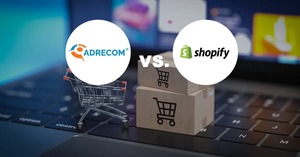
What is a Legacy Application or System?
Legacy applications are those that have grown over many years as an enterprise has developed, and they usually have unique features and capabilities essential to the business’ operation. As a result, they are difficult to replace or integrate with emerging modern systems and technologies. Organizations often run outdated web properties comprised of large collections of html pages built over long periods by many different people, or home-grown software, created by individuals no longer with the organization, with structures that no one knows enough about to feasibly add new elements. Some companies run large commercial systems that are very expensive to upgrade or that originated with vendors no longer serving the market. Still others use open-source systems like WordPress that, while simple to set up and use, don’t support the more advanced options required, or are very time consuming or expensive to modify or supplement.
There are many reasons why business legacy web applications remain in use but don’t keep up with emerging technologies (stagnation) over long periods of time. It’s common for managers to postpone a legacy system transformation for as long as possible. The process requires effort, coordination, and focus. Legacy applications may be highly customized and uniquely suited to the business, and thus difficult to change. Budgetary constraints often divert scarce resources to other priorities. Many legacy systems are mission critical and so managers are hesitant to make changes that carry risks to operational stability. Sometimes it’s just a matter of being overwhelmed by the prospect of upsetting the applecart (disrupting or destabilizing existing systems the business is highly dependent upon) that causes companies to put off what they know is inevitable.
Regardless of the cause, eventually the need to migrate becomes an imperative.
Knowing when you Need a Legacy Transformation
How does an organization know that it’s time to migrate content and applications to a CMS? Effective ecommerce is an essential part of the modern business landscape, and it exists amid rapid technological advancement. An enterprise’s applications and web presence must keep up, and interface, with emerging technologies to remain effective, and to take advantage of associated opportunities.
Unfortunately, every enterprise eventually gets to the point where its failure to modernize directly and adversely affects revenue and brand positioning. Worse, as they age, systems can fall out of compliance with regulatory requirements like PCI , HIIPA, etc. or can cause system crashes, rendering them essentially impossible to use. Keeping up with ecommerce technologies therefore directly affects the bottom line.
Today, web presence, its functionality and access must be very dynamic and interactive. Legacy systems need to keep up with and adapt to process improvements such as workflow, mobile solutions, and social-media integration. As technologies advance at accelerating rates, the pressure to keep legacy systems updated increases.
Business reasons for legacy transformation are many, and include:
- Providing current online interfaces for others (customers, partners, suppliers) to transact business directly with in-house systems.
- Permitting a mobile workforce to access company information, applications, functions, and processes while in the field.
- Increasing enterprise productivity by improving processing, workflow, and information access and sharing.
- Electronic interchange solutions, often conforming to industry standards or regulatory requirements.
- Improved quality and efficiency for customer and supply-chain interaction.
- Executive information and analysis.
IT departments have a distinct set of reasons for migrating a legacy system:
- Legacy languages are hard to support as related tools become hard to find.
- People who know the legacy language become increasingly scarce. Younger staff members don’t learn "legacy" languages because it doesn’t advance their career objectives.
- The underlying platform and related legacy hardware is hard to support as capable technicians become more difficult to find.
- Legacy software architecture does not integrate well with later, more pervasive IT systems.
- IT departments forced to maintain aging legacy environments to sustain day-to-day operations find their task increasingly difficult and costly; and their ability to innovate and improve diminished.
Legacy Transformation or so-called Online Presence Modernization
Transforming legacy applications and systems is unavoidable for enterprises that must keep up with or stay ahead of their competition to survive or grow. At some point they must undertake the task. Yet, legacy transformation is a difficult, time consuming, meticulous (not easy) process. It requires organizations to allocate significant resources, train management teams in transition issues, select complex technology and qualified providers, transfer legacy content, and ensure minimal operational interruption.
Migrating contentto a Content Management System (CMS) is a daunting task. Content accumulated over many years creates a maze of structured and unstructured data that can make the migration process appear futile or highly disruptive to ongoing operations. A key part of the process is permitting the organization to continue to derive value from their stable business applications while implementing a transition plan over time that both controls and minimizes costs and risks.
Every
organization's migration task is unique; each has a unique set of legacy
technologies (languages, databases, screens, job control, processes, security,
operating systems) and a unique set of target technologies. Every enterprise
therefore needs a conversion system and service provider that can handle all
aspects of its unique configuration, not just some parts of it. It’s also
important to ensure that the provider/service undertaking the legacy migration
process can design and implement custom translators to meet all requirements of
the customer's migration task, not just a few. The process, to be effective and
successful, needs a proven system for implementing custom translators that’s
capable of handling multiple source and target languages and scaling to
millions of lines of code.
Developing a plan for Legacy Management and Transformation
Assessment and planning is essential to effective, successful migration. Before moving forward with any plan, it’s important to know where you are and where you want to go. To fashion the best approach, organizations must clearly identify why transformation is necessary, the IT and business objectives (and priorities) at stake, and the costs and benefits of attaining those objectives. The transformation has to be understood and accepted by all key players within the organization. It’s also best to have enterprise-wide commitment to the process and its requirements both financially and otherwise to ensure that the transformation is completed and succeeds.
Important steps in formulating your plan for transformation should include:
- Assess your current enterprise application portfolio.
- Define an effective, economical transfer plan that minimizes risk and corresponds to your budget.
- Determine what type of transformation makes the most sense in the circumstances (the risk and cost of transformation varies by type – starting from scratch typically carries higher risks than an evolutionary transformation) :
- Modernize – Are incremental additions are appropriate as part of the process?
- Replace – Is a “start from scratch, ground up redesign and redevelopment” approach is most advisable? This is commonly known as the "rip and replace" or "Big Bang" approach to transformation.
- Convert – can applications be converted to a new platform or language?
- Extend – can new applications be effectively attached to the existing legacy system?
Through a complete assessment and wise planning, companies can competently and safely leverage their existing application assets to take advantage of modern ecommerce and enterprise capabilities. With the right transformation plan any organization can realize a powerful return on its investment in today’s innovative e-solutions.
Transforming a legacy application into a modern, services-oriented, flexible application architecture takes commitment, focus, budget, and effort. It doesn't happen overnight. There isn’t a “snap” solution. A well-staged incremental transformation process can meet an organization’s tactical operating needs, as can a full-scale replacement, and both can be accomplished safely and effectively with the right commitment to the process and the right service provider. The result won’t only transform the legacy systems, it can transform an organization into an industry leader.




